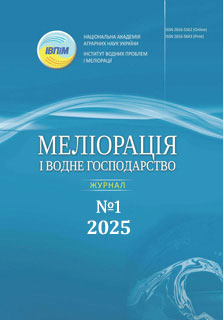THE IMPACT OF CLIMATE CHANGE ON EVAPORATION FROM THE RESERVOIRS OF THE SOUTHERN BUG BASIN
Abstract
The article deals with the issue of assessing the level of flow regulation of the Southern Bug River Basin within Khmelnytskyi and Vinnytskyi regions. The Southern Bug River Basin is one of the most regulated river basins in Ukraine, with 17 % of reservoirs and 20 % of ponds of the total number in Ukraine. Many of them are in extremely poor condition. Overgrowth, siltation, and bank degradation in many small reservoirs have led to a significant reduction in their volume, an increase in the area of shallow water, disrupted soil nutrition, and caused intensive development of higher aquatic vegetation. Studies have shown that water losses to evaporation in the reservoirs of this basin amount to 25,6% of their total volume, or 50,2% of the useful volume. At the ponds, losses are much higher and amount to 66,7% of their total volume. In general, evaporation losses in the Southern Bug River (up to the border with Kirovohradskyi region) amount to 17,6% of its average annual value over the long-term observation period. A significant increase in evaporation from the water surface has been observed in recent decades, due to an increase in air temperature during the growing season. While in the very low-water years of the last century, evaporation losses of the Southern Bug amounted to 38,3% of the annual runoff, in 2020 they reached almost 70%. The greatest increase in evaporation is observed in the summer months, due to an increase in daily maximum air temperatures and the number of days with average daily air temperatures above 30 0C. To solve the problem of conservation and efficient use of water resources, it is necessary to introduce a comprehensive system of organizational and technical measures, including optimization of the number of reservoirs in river basins, taking into account the level of flow regulation and economic needs; increasing the volume of functioning reservoirs by clearing their l
References
2. Hrebin, V.V., Khilchevsky, V.K., Stashuk, V.A., Chunaryov, O.V., & Yaroshevich, O.E. (2014) Vodnyi fond Ukrainy. Shtuchni vodoimy. Water Fund of Ukraine. Artificial reservoirs. Reservoirs and ponds]. Kyiv: Interpres, 163. [in Ukrainian].
3. Khilchevsky, V.K., & Hrebin, V.V. (2021). Velyki i mali vodoskhovyshcha Ukrainy: rehionalni ta basinovi osoblyvosti poshyrennia [Large and small reservoirs of Ukraine: regional and basin-specific distribution features]. Hydrolohiia, hidrokhimiia i hidroekolohiia, 2 (60). [in Ukrainian].
4. Palamarchuk, M.M., & Zakorchevna, N.B. (2001). Vodnyi fond Ukrainy [Water Fund of Ukraine: possible solutions]. Kyiv: Nika-Tsentr, 392. [in Ukrainian].
5. Kozytskyi, O.M., Shevchuk, S.A., Shevchenko, I.A., & Logunova, N.V. (2020). Prychyny ponyzhennia rivnia ozera Synie ta zakhody shchodo pokrashchennia yoho ekolohichnoho stanu [Factors of lowering the Lake Syne levels and measures to improve its ecological state]. Melioratsiia i vodne hospodarstvo, 2, 112-188 [Factors of lowering Lake Syne levels and measures to improve its ecological state]. [in Ukrainian].
6. Poriadok vstanovlennia rezhymiv roboty shtuchnykh vodnykh obiektiv ta vodohospodarskykh system. Order of the Ministry of Environmental Protection and Water Resources of Ukraine of January 20, 2022 [Procedure for establishing operating modes of artificial water bodies and water management systems. Order of the Ministry of Environmental Protection and Natural Resources of Ukraine dated January 20, 2022]. Retrieved from: https://zakon.rada.gov.ua/laws/show/z0280-22#Text. [in Ukrainian].
7. Timchenko, V.M. (2006). Ecological hydrology of reservoirs of Ukraine. [Ecological hydrology of reservoirs of Ukraine]. Kyiv: Nauk. dumka, 383. [in Ukrainian].
8. Dubnyak, S.S. (2007). Ekoloho-hidromorfolohichnyi analiz problem pidtoplennia zemel u zoni vplyvu Dniprovskykh vodoskhovyshch [Ecological and hydromorphological analysis of land flooding problems in the area of influence of the Dnipro reservoirs]. Nauk. pratsi UkrNDHMI, 2, 1-15. [in Ukrainian].
9. Shevchuk, V.Ia. (1999). Rekomendatsii shchodo polipshennia ekolohichnoho stanu pryberezhnykh terytorii Dniprovskykh vodoskhovyshch [Recommendations for improving the ecological condition of the coastal areas of the Dnipro reservoirs]. Kyiv: KSP, 182. [in Ukrainian].
10. Pichura, V.I. (2016). Prostorovo - chasovi zminy trofichnoho stanu vodoskhovyshch richky Dnipro [Spatial-temporal changes in the trophic state of the Dnipro River reservoirs]. Visnyk NUVHP, 4(76), 3-21. [in Ukrainian].
11. Tavrel, M.I. (2021). Obhruntuvannia shliakhiv podolannia evtrofikatsii vodoim. [Justification of ways to overcome eutrophication of water bodies] Problemy ekolohii, 1 (23), 73 -79. [in Ukrainian].
12. Vishnevsky, V.I., & Kutsy, A.V. (2022). Bahatorichni zminy vodnoho rezhymu richok Ukrainy [Long-term changes in the water regime of Ukrainian rivers]. Kyiv: Naukova dumka, 250. [in Ukrainian].
13. Shereshevsky, A.I., & Synytska, L.K. (2003). Rozrakhunkove vyparovuvannia z vodnoi poverkhni na terytorii Ukrainy Nauk [Estimated evaporation from the water surface on the territory of Ukraine]. Reports of UkrNDHMI. 252, 11-19. [in Ukrainian].
14. Shereshevsky, A.I., & Synytska, L.K. (2006). Suchasna otsinka rozrakhunkovoho vyparovuvannia z vodnoi poverkhni dniprovskykh vodoskhovyshch z metoiu yogo vrakhuvannia pry rozrobtsi rezhymiv roboty HES [Modern assessment of calculated evaporation from the water surface of the Dnieper reservoirs in order to take it into account when developing the operating mode of the hydroelectric power station]. Nauk. pratsi UkrNDHMI, 255, 213-227. [in Ukrainian].
15. Obukhov, E.V. (2014). Determination of water losses due to evaporation from Dneprovsky reservoirs using a generalized formula [Determination of water losses due to evaporation from Dneprovsky reservoirs using a generalized formula]. Ukrainian Hydrometeorological Journal, 14, 136-143. [in Ukrainian].
16. Vyshnevskyi, V.I., Donich, O.A., & Kutsy, A.V. (2023). Climate of Kyiv and its surroundings [Climate of Kyiv and its surroundings]. Kyiv: Varto, 124. [in Ukrainian].


